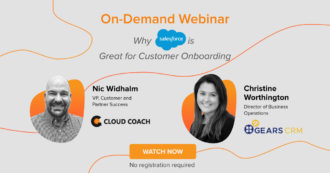 Webinar
Webinar
- Solutions
- Customer Onboarding
- Customer Success
- Professional Services Automation
- Project Management
- Project Portfolio Management
-
Solutions
-
Features
- Why Cloud Coach
- Customers
-
Resources

While churn rates and retention rates are conceptually similar, they are themselves two distinct metrics that can help businesses improve products and customer engagement strategies. As many modern businesses continue to grow and adapt to new technologies and ways of optimizing various business operations, organizations are increasingly relying on data – like churn rates and retention rates – to inform business decisions.
And as data aggregation technologies improve and provide better, higher-quality assessments of customer behavior and market trends, the companies that have their finger on the pulse will be able to adapt quickly and potentially gain an edge over direct competitors.
So what is a good churn rate for a small or medium-sized business? It depends upon who you ask, but in general terms, having an annual churn rate in the single-digit percentages is decent churn by many estimates. In some industries, the churn can be higher and companies can still operate profitably. In some industries, it’s better to strive for even lower churn rates.
It really depends on your organization’s primary objectives and general business practices. Larger enterprises may have more resources to target lower churn percentages, for instance, but this isn’t always the case.
To understand more about churn rate vs retention rate, it can help to utilize a churn rate vs retention rate formula. There are a handful of helpful formulas you can research online, and many customer data platform solutions have churn and retention analytics built in.
Good churn rates and retention rates can help organizations facilitate stellar project management and service levels. Businesses with good customer churn can also spend less time trying to reduce churn and more time improving products and services, providing excellent customer service, and improving workflows.
What is Retention Rate?
While we have discussed some of the differences between churn rates and retention rates, what is retention rate and why is it beneficial to know? Customer retention rates refer to the measurement of the number of customers a company doesn’t lose over a specific time frame. In other words, customer retention is the inverse of customer churn. So to decrease an organization’s customer retention rate would be to increase its customer churn rate (and vice versa).
Retention rates are important because they largely represent a loyal body of customers that continually patronize a business for its products or services. A common strategy to improve customer retention is to improve various aspects of the customer experience up to and including customer satisfaction. Generally speaking, more satisfied customers are more likely to return to a place of business. How exactly an organization might go about improving experiences and satisfaction levels for customers may differ substantially.
For example, an organization with a fairly stable customer retention rate might seek to improve revenue streams by bolstering retention rate figures. The company could consider a new customer engagement strategy aimed toward providing higher quality customer service, or the marketing department might send out a customer survey questionnaire so the business can more accurately access customers’ pain points and devise better solutions.
ADDITIONAL LINKS
Churn Meaning
In business applications, there are a few different types of churn that are important to understand – revenue churn, customer churn, net MRR (monthly recurring revenue) churn, and gross MRR churn. In general terms, however, churn meaning is typically related to the number of customers who have stopped utilizing a specific product or service.
Revenue churn – This term refers to how much money a company loses to lapsed subscriptions over a specified time frame.
Customer churn – As we’ll explain in greater detail a bit later on, customer churn refers to how many customers a company “loses” over a specified time frame.
Gross MRR churn – This figure represents the percentage of monthly revenue lost to canceled or terminated contracts.
Net MRR churn – Like gross MRR churn except for the fact that net MRR churn also takes into consideration additional revenue gained by customer upgrades and/or expansions from customers who did not cancel contracts or subscriptions.
Churn vs Turnover
There are a lot of terms that mean similar things to churn and the exact terminology may vary somewhat from industry to industry. More often than not, a B2B churn rate is going to be slightly lower than an average B2C churn rate, for instance. In this section, we will go over the nuances and differences between certain terms related to churn that are sometimes used interchangeably (even when the terms themselves aren’t entirely interchangeable).
Churn vs turnover – These two terms are similar but there are a couple of important distinctions between churn and turnover. Every company experiences churn and turnover. However, churn refers to the number of employees departing the company within a specific time frame, whereas turnover more generally refers to the process of a company hiring and losing some employees.
Churn rate vs attrition rate – Like churn and turnover, these two concepts are very similar. There are some key differences, though, that are helpful to know for business owners in the process of improving such metrics. Think of attrition rate as a type of churn that refers to when a company loses an employee because the employee voluntarily left and the company decides not to rehire for the vacated position.
Churn Rate Calculator
In order to accurately determine your organization’s churn, you can utilize a churn rate formula or churn rate calculator. There are dozens of in-browser options available online, but the basic churn formula looks something like this: lost customers divided by total customers at the start of the specified time frame multiplied by 100. So for a business with 400 customers at the starting point that loses 80 customers, simply divide 80 by 400 which results in 0.2. Multiply 0.2 by 100 and you get 20, or a 20% churn rate for the specified duration.
Your business may benefit from looking at weekly churn rates, monthly, quarterly, and annually. While it’s generally reported as a monthly or annual rate, there are many advantages to observing trends and fluctuations in your organization’s churn rate over time. Businesses can identify customer behavior trends and conduct other analyses to develop better customer engagement and customer retention strategies – which we will discuss in greater detail later on.
Because no two organizations are exactly alike, the churn rate SaaS companies experience may vary widely from company to company. Some companies may be able to operate successfully with higher churn rates simply by the virtue of their business model. On the other hand, a company that consistently has a low churn rate is able to retain customers and maintain a steady stream of revenue.
Retention Rate Calculator
To understand how to calculate customer retention rate, it helps to use a customer retention rate formula or a retention rate calculator. A retention rate formula generally refers to how many employees an organization has divided by the number of employees from the previous year. For example, if an organization employs 90 people at the end of a calendar year, but the previous year the same company employed 100 people, the retention rate would be 0.9, or 90 percent. The same formula could be applied when determining customer retention rates as well.
There are a number of benefits to maintaining a high employee retention rate. In addition to the cost savings from not having to hire recruiters and spend time and resources training new hires, better retention rates can also help increase productivity levels and allow agents to develop better, stronger relationships with clients and customers. Better employee retention can also allow for higher employee engagement, improved workplace culture and morale, and enhanced collaboration and trust between employees and departments.
When employees have an opportunity to grow within an organization, they can feel more attached or invested and put forth more effort than a temp might or relatively new hires. While it’s important to search for new talent and regularly acquire new employees that help your business grow and thrive, maintaining a high retention rate is a key component of many organizations’ success.
How to Measure Customer Retention Rate
As previously alluded to, no two businesses are identical and so the average customer churn rate by industry is going to vary somewhat from company to company (and from industry to industry). It may be helpful to research some of the retention and turnover figures for your organization’s specific industry, and you may also be able to locate your company’s main competitors’ information about retention and turnover. This can provide an overview of the general atmosphere within an industry, and business owners may be able to identify trends and other insights related to the customer retention process.
As for how to measure customer retention rate, a business can utilize a customer retention calculator or retention formula. In some cases, a robust customer data platform (CDP) or a customer relationship management (CRM) platform can help provide insights related to retention rates, turnover rates, and other valuable information.
A churn rate example might help prepare marketing teams to develop better customer engagement strategies and identify previous techniques or methods that were not as effective. With greater access to customer data – especially customer engagement and satisfaction data – marketing departments can devise more effective strategies that help reduce customer churn and broaden an organization’s revenue streams.
See Cloud Coach In Action
We’d be happy to provide a bespoke 1:1 demo on how Cloud Coach can benefit for your business.























